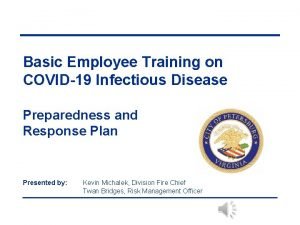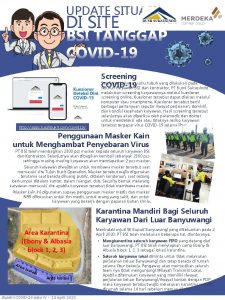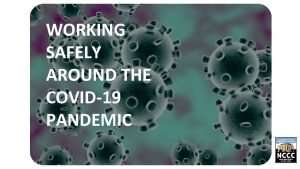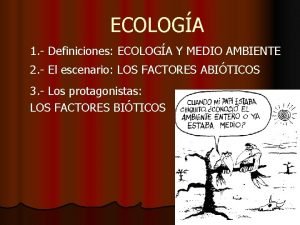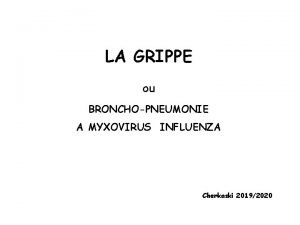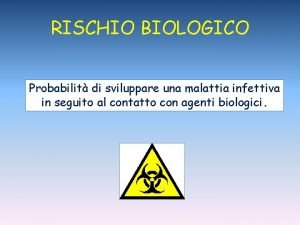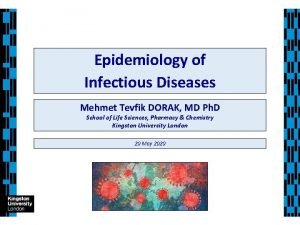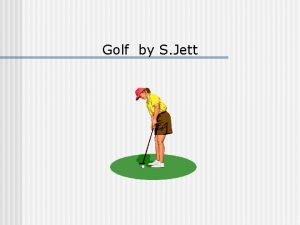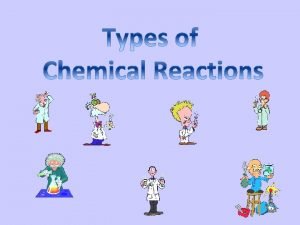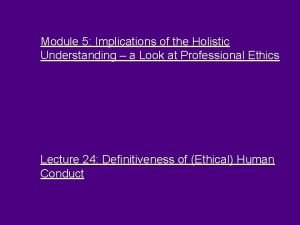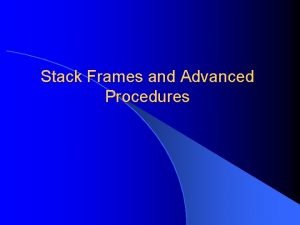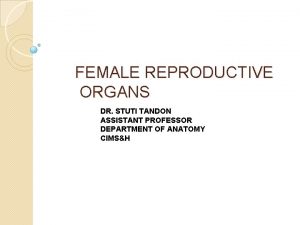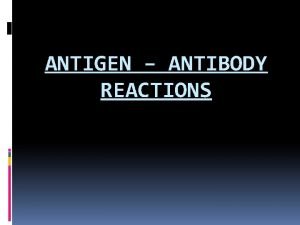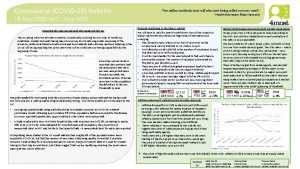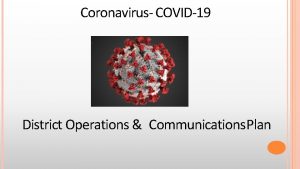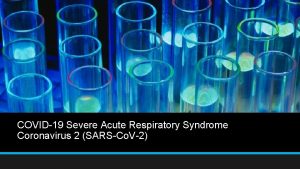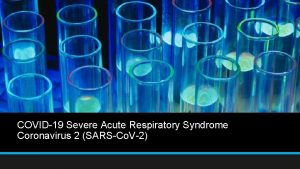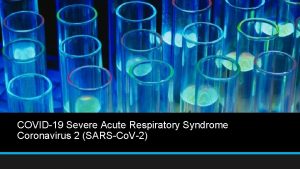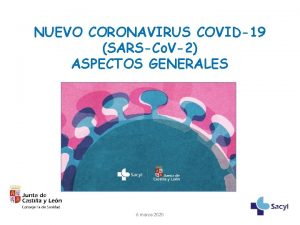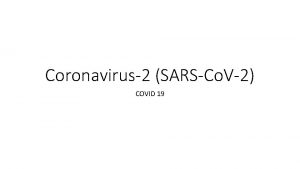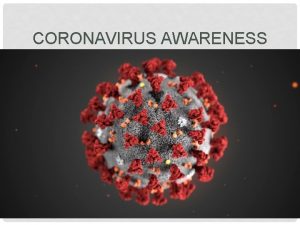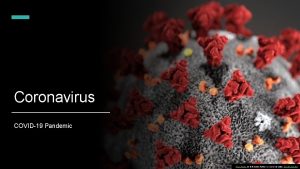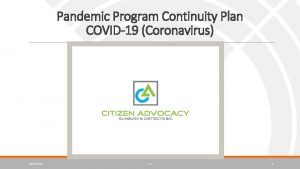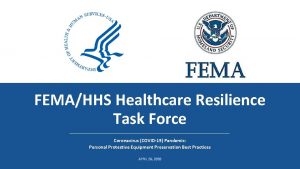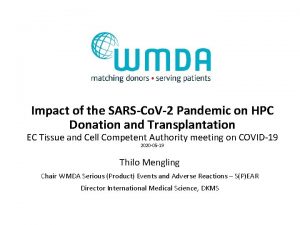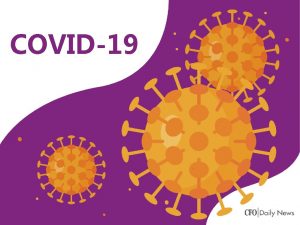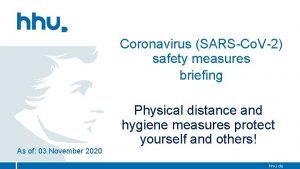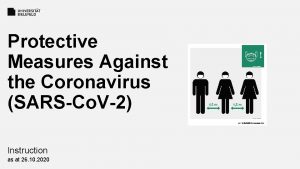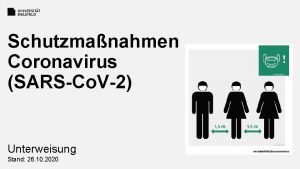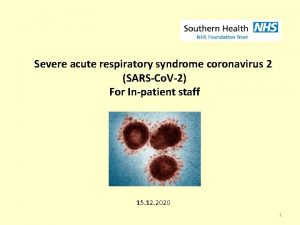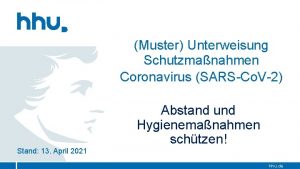Coronavirus COVID19 Pandemic Coronavirus Also known as SARSCo



























- Slides: 27

Coronavirus COVID-19 Pandemic

Coronavirus • Also known as “SARS-Co. V-2” (Severe Acute Respiratory distress Syndrome) • Disease it causes called “COVID-19” (Coronavirus Disease 2019) • Declared a public health emergency on January 30, 2020

Coronaviruses • Large family of viruses common in camels, cattle, cats, and bats • Current outbreak of SARS-Co. V-2 is a betacoronavirus emerging from a bat origin • First reported in Wuhan, Hubei Provence in China with a link to live animal market

WHO Situation Report January 23 rd - 571 confirmed cases in China - First confirmed case in the United States

WHO Situation Report February 9 th 37, 558 confirmed cases globally - 37, 251 in China - 307 outside of China - 12 in U. S.

WHO Situation Report March 1 st 87, 137 confirmed cases globally - 79, 968 in China - 7, 179 outside of China - 62 in U. S.

WHO Situation Report March 16 th 153, 517 confirmed cases globally - 81, 048 in China - 72, 469 outside of China - 1629 in the U. S.

United States: March 1 st Confirmed cases in: Arizona, California, Illinois, Massachusetts, Oregon, Washington, and Wisconsin - 62 cases total (48 via repatriation to U. S) - No confirmed deaths of COVID-19 in U. S.

United States: March 9 th Confirmed cases in: 35 states - 423 cases total (328 under investigation) - 19 confirmed deaths of COVID-19 in U. S.

Current: United States Confirmed cases in: 47 states - 1629 cases total (1362 under investigation) - 41 confirmed deaths of COVID-19 in U. S.

Routes of Transmission • Primarily infects epithelial cells of respiratory and GI tract • Viral shedding occurs via these systems • Opens to variety of transmission routes: airborne, fecal-oral, fomites

Primarily spreads person-person via respiratory droplets Spread Less commonly by contact with sputum, serum, and blood Incubation period estimates that symptoms occur 2 -14 days after exposure Possible spread during incubation period when patients are asymptomatic

Latency? ? ? asymptomatic period of development in host

Alternative Routes • While not the main route of transmission, there is documented spread from surfaces or objects • Fomites • objects or materials which are likely to carry infection, such as clothes, utensils, and furniture

Morbidity and Mortality As of March 16 th, there have been 153, 517 confirmed cases worldwide with 5, 735 deaths (3. 7% mortality rate) Majority of cases are in the adult population with only 2. 1% of cases patients below age 20

Most common reported symptoms include fever, dry cough, shortness of breath Morbidity and Mortality 14% of patients experienced severe disease with 5% critically ill Illness severity associated with age > 60 years and co-morbid disease

Close Contact • Defined as within 6 feet of another individual • Best way to prevent illness is avoid exposure

Call your doctor If You Are Sick Stay home until instructed Stay away from others If you must go out in public wear a facemask

Facemasks should be utilized by those with symptoms of COVID-19 disease CDC does not currently recommend use of facemask by healthy individuals Prevention & Treatment Hand Hygiene with soap and water or alcohol-based hand sanitizer with at least 60% alcohol No current antiviral treatment Oxygen therapy for those with severe respiratory distress is current best practice

Best Practices: General Population Avoid touching eyes, nose, and mouth Avoid contact with sick individuals Stay home if you are sick Hand Hygiene with soap and water or alcohol-based hand sanitizer with at least 60% alcohol Contact healthcare provider immediately if you think you may have been exposed to COVID-19

• CDC recommends that for next 8 weeks, organizers cancel or postpone in-person events that consist of more than 50 people Next Steps • Stay up to date on CDC situation updates

Coronavirus prediction: No interventions

Coronavirus prediction: If interventions start in March

Coronavirus prediction: If interventions start in June

Coronavirus prediction: If interventions start in July

Intervention Graphic • The point of a model like this is not to try to predict the future but to help people understand why we may need to change our behaviors or restrict our movements, and also to give people a sense of the sort of effect these changes can have

 Covid19 athome rapid what know
Covid19 athome rapid what know What do if test positive covid19
What do if test positive covid19 Http://apps.tujuhbukit.com/covid19/
Http://apps.tujuhbukit.com/covid19/ Vaksin covid19
Vaksin covid19 Do if you covid19
Do if you covid19 Who pandemic phases
Who pandemic phases Pandemic tabletop exercise template
Pandemic tabletop exercise template Mathalicious pandemic answer key
Mathalicious pandemic answer key Covid 19 pandemic summary
Covid 19 pandemic summary Pip framework
Pip framework Tres abióticos
Tres abióticos Scissurite coronavirus
Scissurite coronavirus Contatto indiretto
Contatto indiretto Rischio biologico coronavirus | titolo x d.lgs. 81/08
Rischio biologico coronavirus | titolo x d.lgs. 81/08 Relazione finale continuità infanzia primaria
Relazione finale continuità infanzia primaria Bronquite coronavirus
Bronquite coronavirus Mehmet tevfik dorak
Mehmet tevfik dorak Scoring a hole in the prescribed set of shots is called
Scoring a hole in the prescribed set of shots is called Double replacement reaction cartoon
Double replacement reaction cartoon Software is also known as
Software is also known as Definitiveness of ethical human conduct is also known as
Definitiveness of ethical human conduct is also known as The stack frame inside a procedure is also known as the
The stack frame inside a procedure is also known as the Arbor vitae uteri
Arbor vitae uteri Marracks lattice hypothesis
Marracks lattice hypothesis Jeopardy quotes
Jeopardy quotes Voldemort also known as
Voldemort also known as Conformational isomers are also known as
Conformational isomers are also known as Stomatognathic function
Stomatognathic function

